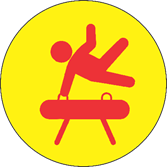Vestibular
The Vestibular Sensory System (how we sense where our bodies are in space)
 Our vestibular system is all about our balance and movement and is centred in the inner ear. We all have vestibular organs located in our inner ear. When we move our heads the fluid in these organs moves and shifts which constantly provides us with information about the position of our heads and bodies. It tells us if we are right side up or upside down, moving forwards or backwards, whether we are dizzy or not.
Our vestibular system is all about our balance and movement and is centred in the inner ear. We all have vestibular organs located in our inner ear. When we move our heads the fluid in these organs moves and shifts which constantly provides us with information about the position of our heads and bodies. It tells us if we are right side up or upside down, moving forwards or backwards, whether we are dizzy or not.
The vestibular sense is perhaps the most important of all our senses as it gives us physical and emotional security; it helps to keep us upright against gravity and it helps us to keep orientated when we bend down as our bodies automatically adjust to stop us from falling. It helps us to move smoothly and efficiently and provides us with confidence to move and interact with our surroundings.
When our vestibular system is working effectively it enables us to feel safe, secure and organised in our bodies so we can then attend and respond to other sensory input; e.g. allowing us to process and respond to sounds in the environment whilst bouncing, or to throw a ball at a target whilst running and watching the target.
With a well-developed vestibular system, we can feel confident and safe in movement activities even with our feet off the ground.
Our brains receive vestibular information and then decide what to do with it. Our initial protective reactions are ‘go for it’, ‘don’t do it’ or ‘precede with caution’. Our brain assesses the situation and establishes if there is a perceived threat or danger; it will then act accordingly.
Difficulties with vestibular
- Unable to sit still
- Rocking in the chair
- Jiggling when listening
- Running everywhere
- Poor balance and posture
- Avoiding activities where feet leave the floor
- Excessive fear of falling
- Car sickness
- Avoiding uneven floor surfaces
General Tips for hypersensitivity
- Ensure that a child who is fearful of movement, playground equipment and who gets car sick easily is in control of the amount of challenging movement that they engage in. They must never be pushed past their limit.
- Always be aware of the sensory strategies that calm a child and that enable them to feel safe and secure. These are useful to prepare a child for challenging work against gravity and to calm and comfort them if they feel unsure or anxious with certain movement activities.
- Place a hard surface under the child’s feet whilst sitting to encourage a feeling of stability.
- Avoid big unexpected movements.
- Provide the child with a safe haven to go to if the setting is becoming too much to cope with, for example consider using a pop-up tent. Encourage short periods of time with a small group to begin to desensitise the child to activities.
- Allow the child to play with low key activities alongside a busier group for short periods.
- Gradually encourage one other child into the child’s chosen play and facilitate quite low key non-threatening games.
Hyposensitivity:
Children with an under sensitive vestibular system may experience an under responsiveness to movement and seek out as much movement as they can; they may constantly be on the go. These children may seek out climbing opportunities, swings, roundabouts, and slides; and they will enjoy hanging upside down on bars and furniture.
They may seek rocking motion. They will not display a sense of danger when climbing and they may trip over their own feet. If a child’s brain is under responsive to vestibular input, then their body wants to constantly move, and spin and they never get dizzy.
General tips for hyposensitivity
- Divert the child to more appropriate large play equipment when they show a desire to climb.
- Divert the child to more appropriate provision if they swing on inappropriate equipment.
- Engage the child in lap play activities.
- Provide regular bursts of gross motor play.
- Provide close supervision on climbing frame equipment.
Activities to try
- Teach the child to use their feet to activate equipment and to become in control, e.g. swinging self on a swing, pushing self along on a Scuttle bug.
- Move legs to pieces of music or during rhymes
- Sing songs such as ‘Row the boat’ and the ‘Roly Poly’ song, etc.
- Use of a large child sized ball (gym ball) and encourage the child to lay their body over it and push back and forth with feet on the floor to encourage a rocking motion; use an accompanying song to help maintain engagement.
- Play games where spinning is part of the fun, e.g. ‘Ring a roses’ and ‘Pin the tail on the donkey’.
- Sing songs and share interactive books with actions that involve swirling around.
- Try pulling and pushing activities using appropriate materials, e.g. lycra bands
- If possible, provide a trampoline or trampette for bouncing on.
